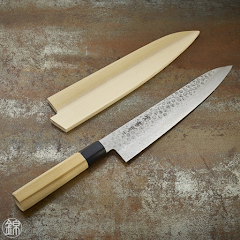Best Japanese Knives of 2022 to Tackle Any Kitchen Task
Knives are the most essential tool in a cook's armory. You'll need an excellent blade to slice and dice your ingredients while cooking at home. There are two types of knives: Western knives, which are primarily created in Germany and France, and Japanese knives, which are primarily made in Japan. Western blades are recognized for their bulk and durability, but Japanese knives are praised for their razor-sharp edges, agile precision, and lightweight. Blades have been perfected in Japan for hundreds of years, dating back to the period of the samurais, who wielded deadly-sharp swords.
Best Japanese Knives
However, the world of Japanese knives can be perplexing—should you start with a nakiri or a santoku, should you seek for a single or double bevel, and can you sharpen at home? These are all topics to ponder while you shop. "A fantastic gyuto (chef's knife) 210-240mm is the perfect home size, or a santoku if you want something a little smaller," Kevin Kent, CEO of Knifewear and author of "The Knifenerd Guide to Japanese Knives," adds. "Then, for lesser operations, a smaller blade, a boning knife for butchery, a nakiri for vegetable prep, a bread knife, and a sujihiki (meat slicer) for carving that Sunday roast," says the author.
When it comes to making sushi at home, chopping through mounds of herbs, and deboning whole poultry, Japanese knives may be invaluable partners in the kitchen—they keep their edge, feel comfortable in the hands of any size, and deliver balanced accurate cuts. After conducting research, we have determined that Miyabi's Birchwood SG2 8-Inch Chef's Knife is the best alternative available.
These are the best Japanese knives, from gorgeous Damascus-patterned gyuto knives that slice through steak like butter to sets with all the blades for a functional kitchen.
Best handmade Japanese knives
The origins of Wa-Bocho, or Japanese-style knives, can be traced back to the time of the Samurai warriors. These classic kitchen blades, which are among the best cutlery available in the culinary world, are still made using the same hand-forging procedures used to make Samurai swords. In traditional Japanese cuisine, the complex knife technique to highlight a chef's talent is emphasized. Japanese chefs use a range of specific Wa-Bocho to prepare vegetables, fish, and meat to acquire this mastery. Japanese knifemakers now produce Western-style knives to meet the demands of chefs all over the world. Because it will affect the integrity of the components, having a sharp knife is an essential part of cooking.
Japanese knives are prized for their intricate and elegant designs and the precision with which they cut. They enable thin, precise cuts and stunning presentation, similar to those in a five-star sushi restaurant. Their blades are often tiny and delicate, and they are prone to shattering if not correctly cared for, making them unsuitable for the clumsy chef.
Japanese Knife Set
The reason Japanese knives have grown so famous around the world, according to Vincent Lau, the lone knife sharpener at Korin, a Japanese knife business in lower Manhattan, is because they're essential in Japanese cuisine: To bring out the flavor of the food by enhancing and preserving the contents.
We have a century of experience evaluating kitchen staples like bread knives, chef's knives, electric knives, butcher knives, and more in the Good Housekeeping Institute Kitchen Appliances and Technologies Lab. We put each knife to the test by shopping through a variety of items, ranging from hard carrots to medium-firm cheeses that are known to stick and delicate herbs like parsley that bruise easily. We put delicate items like ripe tomatoes and fresh mozzarella to the test and onions that are difficult to cut into even pieces with a dull knife. We also tested raw chicken and cooked meat because your knife should be capable of handling any situation. We assess the comfort of the handle and grip in addition to performance.

Comments
Post a Comment